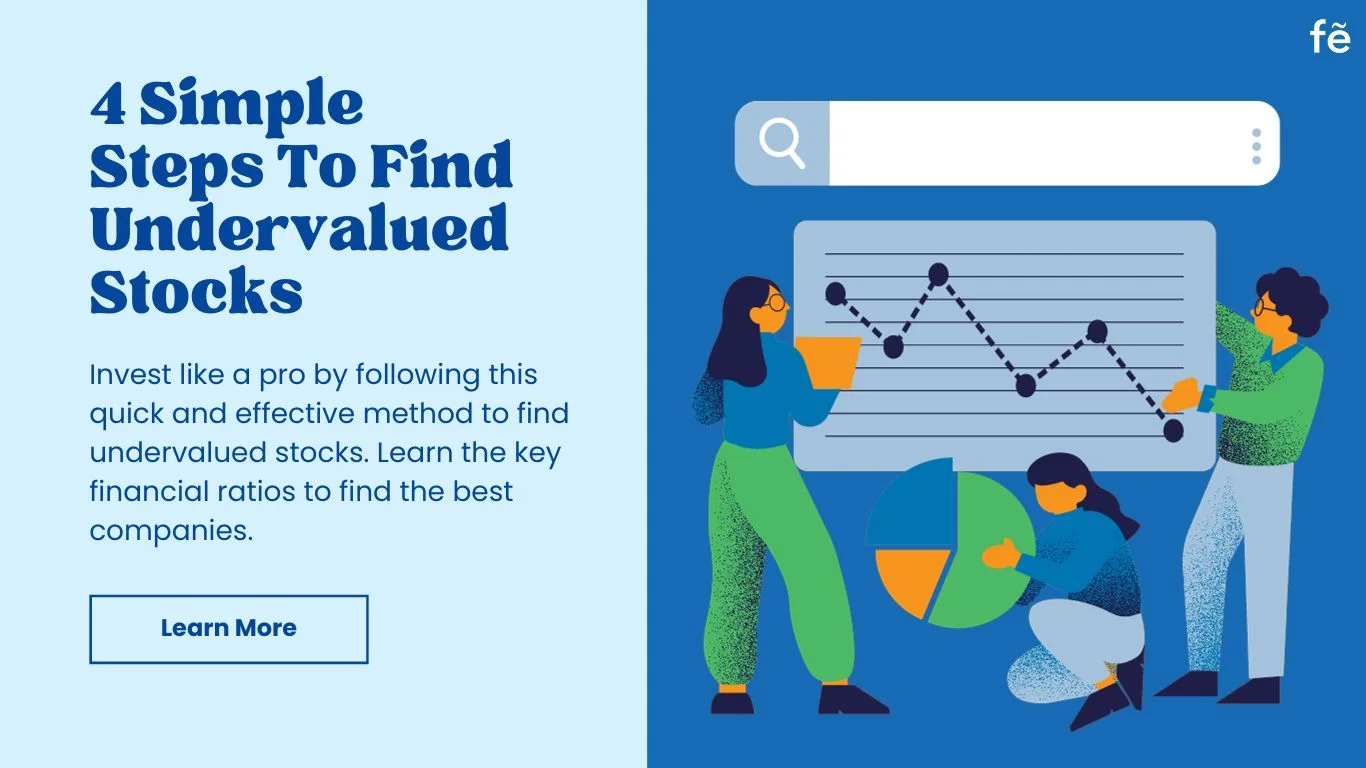
As an investor, I always looking to invest in companies that consistently deliver strong financial performance and are undervalued in terms of their intrinsic value. This way, I can maximize gains and minimize my losses.
However, when there are more than 2,000 listed companies in the stock market, it can be quite challenging to find the best and undervalued companies, isn't it?
So I assume this to be a treasure hunt game and find it quite exciting. Therefore, let's explore a method you can follow step by step to discover an excellent stock at an attractive price. This is the same technique that I personally follow.
So, let's get started without wasting more time.
How To Find Undervalued Stocks In 1 Minute?
The most effective way to filter undervalued stocks is by using a stock screener. This allows you to avoid overpriced stocks in just 1 minute. We should apply this method while focusing on the Indian stock market. That is why websites are also suggested accordingly.
I am using a screener.in here. However, you can also use other websites such as,
Step-1: Define Your Criteria
Before using a stock screener, it's essential to consider financial ratios. These ratios will help you assess the overall financial performance and intrinsic value of the stock, making it easier to decide when to buy.
Ratios To Find Company With Best Valuation:
Price-to-Earnings Ratio (P/E): This ratio simply tells you how much investors are willing to pay for each rupee of a company's earnings. In simpler terms, it helps you understand if a stock is expensive or cheap relative to its profits. Imagine you're buying a lemonade stand. If you pay ₹100 for it and it makes ₹50 a day, that's a P/E of 2.
A lower P/E ratio can suggest the stock is relatively cheap, but it's essential to consider other factors like the company's growth prospects and financial health.
Price-to-Book Ratio (P/B): The P/B Ratio is like a price tag for a stock, telling you how much you're paying for a share compared to the company's actual worth. If it's less than 1, it might be undervalued.
PEG Ratio: The PEG ratio is like a special ratio that helps you decide if a stock is a good deal, taking into account not only its price but also how fast the company is growing.
Here P means Price, as in the current stock price, E stands for Earnings per share (EPS), which is how much profit the company makes for each share of stock and G means Growth rate, or how quickly the company's earnings are increasing.
If the PEG ratio is less than 1 or equal to 1, then you consider the Stock to be undervalued or fairly valued.
Price-to-Sales Ratio (P/S): This is a unique ratio that helps in finding undervalued stocks, and it is difficult to manipulate. Instead of looking at earnings, this ratio focuses on a company's total sales or revenue. It helps you understand how much investors are willing to pay for every rupee of a company's sales.
If the P/S ratio is low, it means investors are paying less for every rupee of sales. The stock might be considered cheaper relative to its revenue.
Price-to-Cash Flow (P/CF) Ratio: The P/CF ratio compares a company's stock price to its cash flow per share. This ratio can help us assess whether a company's stock is attractively priced based on its cash earnings.
A lower ratio can indicate potential undervaluation, but it's essential to consider it alongside other factors, such as the company's growth prospects and financial health when making investment decisions.
Note: Don't always consider these ratios as proportions because they can be high or low according to the industry of the stock. For example, the default PE ratio can be higher in an industry due to its high growth potential. Therefore, it's essential to compare a stock's ratios with those of its industry peers.
Use Ratios To Identify Champion Companies:
Operating Cash Flow: Operating Cash Flow is like the pure profit a company earns from its primary activities, excluding other financial activities. It's all about how much money a company generates from its regular, day-to-day business activities.
It helps you assess how well a company performs at its core business.
If a company's OCF is positive, it means they're making more money from their core activities than they're spending to run those activities. This is a good sign of financial health.
ROA (return on assets): ROA is like a scorecard that tells you how well a company is using its assets to make money. It helps you understand if a company is efficient and profitable in its operations.
A higher ROA generally indicates better efficiency and profitability, while a lower ROA might suggest room for improvement. It's a useful financial ratio for investors to assess a company's financial health and performance.
ROCE (Return on Capital Employed): It is like a financial magnifying glass that helps you assess how effectively a company is using its capital to generate profits. A higher ROCE indicates efficient capital utilization, while a lower ROCE may indicate poor resource management and low profitability. It is helpful to evaluate a company's financial performance.
ROE (Return on equity): ROE is like a gauge that helps you assess how well a company is using its shareholders' equity to generate profits. A higher ROE is a sign of effective profitability, while a lower ROE may signal a need for improvement. Investors often use ROE to evaluate a company's financial performance and its ability to provide a return on investment for shareholders.
Free Cash Flow (FCF): Free Cash Flow (FCF) is like the money left in your wallet after you've paid all your bills. It's the cash a company generates from its operations, minus what it spends to keep the business running and maintain its assets.
If a company's FCF is positive, it means it's generating more cash from its operations than it's spending on maintaining and growing the business. This is a good sign of financial strength and flexibility.
Free cash flow is a critical metric for investors because it indicates a company's ability to grow, adapt, and create value for shareholders while managing its financial obligations.
Asset Turnover Ratio: This ratio helps us measure how efficiently a company uses its assets (like equipment, inventory, and buildings) to generate sales or revenue.
If a company's Asset Turnover Ratio is high, it means the company is making a lot of sales for each rupee invested in assets. This indicates efficient use of resources. Investors and analysts use this ratio to understand a company's operational efficiency and how effectively it's utilizing its resources.
Ratios That Ensure a Secure Investment:
Debt-to-Equity Ratio: The Debt-to-Equity Ratio is like a financial scale that helps you assess how a company is financing its operations. A lower ratio means the company relies less on borrowed money and has a stronger foundation of owner's equity. This can indicate lower financial risk. While a higher ratio may indicate higher financial leverage and risk.
It's a valuable metric for investors and analysts to understand a company's financial structure and potential risk exposure.
Current Ratio: This ratio helps you to ensure financial safety and helps you assess a company's ability to cover its short-term bills. If a company's Current Ratio is greater than 1, it suggests that the company has more current assets than current liabilities. This indicates a healthy short-term financial position and suggests the company can easily meet its short-term obligations.
A lower ratio might signal potential liquidity issues. Investors and creditors use this ratio to gauge a company's capacity to meet its immediate financial liability and expenses.
Quick Ratio: The Quick Ratio is like a more focused snapshot of a company's short-term financial health. It helps you assess whether a company can meet its immediate financial obligations without relying on the sale of inventory, which might take more time to convert into cash.
If a company's Quick Ratio is greater than 1, it means the company has enough quick assets to cover its current liabilities without relying on the sale of inventory. This indicates strong immediate financial health. We can use this ratio to assess a company's ability to handle its immediate financial commitments.
Altman Z-Score: The Altman Z-Score is like a financial health scorecard for a company. It helps predict the likelihood of a company going bankrupt or facing financial distress in the near future.
This score uses a combination of several financial ratios that reflect a company's profitability, liquidity, leverage, and other aspects of its financial health. Each financial ratio is assigned a weight based on its importance in predicting financial distress.
If a company's Altman Z-Score is above 3, it suggests that the company is in good financial health, with a low risk of bankruptcy or financial distress. While the score is between 1.8 and 3, it indicates that the company is at moderate risk, and further analysis is needed to assess its financial stability.
It provides valuable insights into a company's financial stability and is particularly useful when assessing investment or lending decisions.
Interest Coverage Ratio: This ratio tells whether a company can comfortably meet its interest payments on loans and bonds. It helps assess a company's ability to handle its financial obligations and avoid defaulting on its debt.
A higher ratio generally suggests a lower risk of default, while a lower ratio may raise concerns about the company's financial health. We can leverage this ratio to evaluate a company's risk when servicing its debt.
Step-2: Apply Your Favorite Combination Of Ratios

Now that you have learned about all these financial ratios, you can create a perfect formula by using combinations of your favorite ratios. Let's find out how.
For this, I am using the screener.in website. It provides an option to create custom stock screens. Just like the example below, can also create your own custom filter.

Debt to equity < 0.8 AND
Net profit > 100 AND
Operating cash flow 3years > 100 AND
Promoter holding > 60 AND
Price to book value < 2

Here, we can also filter companies that recently released the latest quarterly results and even modify columns to view the ratios of these companies.
Step-3: Conduct a Comparative Analysis

Comparison With Competitors: When you come across a company with a low valuation and strong performance, don't rush to buy it. It's essential to analyze it further.
Imagine you prefer a specialty chemical manufacturing company. To determine whether this company is genuinely undervalued or not, you should compare it with other companies in the same industry.
In this comparison, you can assess both financial performance and valuation ratios, just as you've done before.
Check Historical Valuation Metrics: In the previous method, we compared the target company’s performance with its peer companies, so here, we need to assess a company's past performance or valuation metrics before selecting it
For example, if a company's average PE ratio over the last 10 years is 25, and it is currently trading at 22. In typical circumstances, this PE ratio might be considered high. However, in our case, this company is identified as undervalued.
Step-4: You Are Ready To Buy
If you have selected a company that meets all these valuation metrics, you can consider buying the stock. However, if the company appears to be significantly overvalued, you can also set a price alert. This way, you can purchase the company's shares at a perfect valuation.
Alternatively, if you have more confidence in your selected company's business and financial performance and believe that it will grow significantly in the future. You can buy it even at a higher valuation and get 10X profit by holding for the long term.
Remember one more thing. Do not invest in any company with very small capital. For example, if you have 1 lakh rupees, consider investing a minimum of 5% to 10% of your capital in one company. So that the gain in any stock is reflected in your overall portfolio.
Disclaimer: Finding undervalued stocks is a complex process. Some undervalued stocks might stay undervalued or even go down more. So, it's essential to be careful and make informed decisions.
You May Also Like:





